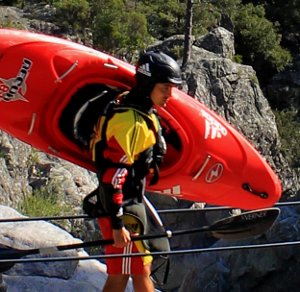
Following a recent fatality, I felt very sad about the frequency of deadly accidents happened in the river in Italy and all over the world. Too many families destroyed and too many friends lost.
I ended up asking myself why accidents happened and what we could do to stop them. After consulting with a lot of experienced paddlers and with the help of risk analysis principles, I put together few concepts, which are not going to make a kayaker immortal, but at least help to better understand what we are risking and experience the river in more conscious way.
The risks in the river
When we drive on a street we generally don't think that if we lose the control of our car we could have potentially deadly consequences if we hit a tree, a house, another car coming in the opposite way, etc... There are a lot of situations where we can't mess up the “line” of our vehicle if we don't want to crash badly against something.
The river is not very different from the road, the potentially deadly places are countless. I'm not talking only about siphons, undercuts and caves, but also of rocks which could entrap your leg while you are swimming or the possibility of hitting your head and losing consciousness.
I understand this kind of thoughts could make us feel bad while we are enjoying the river but forgetting them, could be a fatal error. The first step to increasing safety is to see the risks rather than just paddling the river like nothing could never happen.
The river rescue
Improving our rescue skills can be very useful, everybody should be able to throw a safety rope, set up a good safety on a drop, do Basic Life Support, etc. However, even if you are driving the safest car on the world, if you hit a tree too fast you have no chance of surviving.
Rescue techniques can sometimes solve situations which arise on the river, but in practice their application on real cases is very limited and generally there are very few things a rescuer can try in the short time available, for example in the case of a person trapped underwater.
In the past cases of deadly accidents I've heard about, there was really nothing that could be done to save the person in trouble.
The rescue technique are certainly important, but in my opinion these are not the solution we are looking for to reduce the number of accidents.
Think safe
We just said the river always has dangerous places and potentially deadly risks. Of course there are more dangerous rivers and others with very few risks. The formation of the rocks, trees, vegetation in river bed, artificial elements like iron parts, water levels and a lot of other factors can change the level of hazard of a river. It's crucial to understand what can be dangerous and should be avoided, but the most important thing is to understand there could be hidden risk we can't see. Having said that, we can basically assume that any time we don’t get a clean line through a drop or a rapid, we run into a potential accident. Of course these risks can be very small if we swim on a relaxing and deep class II river and could be quite high if we get recirculated in a hole in a class V boulder garden.
Any time we make a mistake while we are kayaking we are running into a potentially risky situation.
This simple concept leads us to a simple conclusion: the more mistakes we make on a river, the more is the risk we running into. The total risk we are accepting when we run anything, is the river risk multiplied by the number of mistakes we are going to make. Of course nobody can assume his or her technique is perfect and is not going to make any mistakes, so having zero risk is not possible. I think there is always a residual risk in all the paddle sports. I am not suggesting that you need to stop living adventurously, but this risk should be smaller than the one we are running when we drive to get to the river.
Understand this simple concept of risk could make us more conscious of what we are running into when we decide to do a descent. Only correct evaluations of the risks and good decisions from everybody can reduce the number of accidents happening.
If you want to run harder rivers more safely, you simply need to improve your skills enough in order to make very, very, very few mistakes. Physical training, modern kayak technique, high performance gear and good river-reading skills are the biggest keys to save your life and to run the river with respect and satisfaction.
I see too many people around me running drops which are outside of their ability and usually swim one or more times every descent. Generally nothing happens to them, but this kind of kayaker is taking too many risks in my view. My advice for them is to take a step back, paddle rivers where you can feel confident and not risk their life.
Author: Michele Ramazza, revision: Paula Volkmer
Please feel free to share this article.


